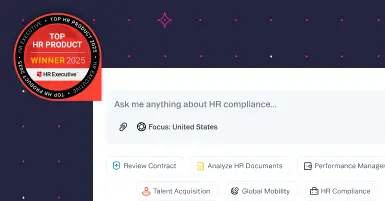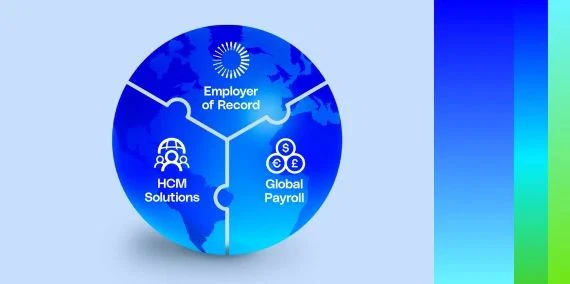Expanding your business into the United States requires hiring local talent and establishing a compliant payroll system that meets all legal obligations. Navigating the country's multi-layered tax structure is a critical first step for any company planning to operate in this new market.
U.S. payroll and tax regulations
Payroll in the U.S. is governed by federal, state, and sometimes local laws, creating a complex compliance landscape. Employers must stay informed to adapt to changing laws and ensure seamless operations. Employers are responsible for correctly calculating, withholding, and remitting all required taxes from employee wages.
-
Federal income tax: The U.S. uses a progressive tax system with seven federal income tax brackets. As of 2025, these rates range from 10% to 37%. Employers determine the correct withholding amount for each employee based on the information provided on their Form W-4. These brackets are adjusted annually by the Internal Revenue Service (IRS) for inflation.
-
State and local income tax: In addition to federal tax, most states and some municipalities levy their own income taxes. These vary significantly, with some states using progressive brackets, some a flat rate, and a few having no state income tax at all.
U.S. payroll cycles
In the United States, pay periods can be weekly, bi-weekly, semi-monthly, or monthly. The pay cycle you choose affects your costs, resource planning, and compliance.
Weekly cycles are common for hourly workers because they simplify overtime calculations. In contrast, monthly cycles are often used for salaried roles because they make tracking earnings easier. Choosing the right pay cycle helps you manage payroll efficiently and keep teams satisfied.
Key payroll contributions in the U.S.
Beyond income tax, employers must manage several other mandatory contributions.
-
FICA taxes: The Federal Insurance Contributions Act (FICA) tax is a mandatory payroll deduction composed of two parts:
-
-
Social Security: As of 2025, the tax rate is 6.2% for both the employer and the employee, applied to wages up to the annual limit of USD 177,300.
-
-
-
Medicare: The tax rate is 1.45% for both the employer and the employee, with no wage limit. High-earning employees are also subject to an additional 0.9% Medicare tax, which employers must withhold but do not match.
-
-
Unemployment taxes:
-
-
FUTA (Federal Unemployment Tax Act): The standard FUTA tax rate is 6.0% on the first USD 7,000 of each employee's annual wages. However, employers who pay their state unemployment taxes on time typically receive a credit of up to 5.4%, resulting in an effective federal rate of 0.6%.
-
-
-
SUTA (State Unemployment Insurance): Each state manages its own unemployment insurance program with unique tax rates and wage bases. Rates are assigned to new employers and later adjusted based on their employment history.
-
Navigating payroll taxes across U.S. states
Managing payroll taxes across different U.S. states is complex. Each state has its own rules for withholding, filing, and remitting employment taxes, including state income tax and State Unemployment Tax Act (SUTA) taxes.
An Employer of Record (EOR) offers a comprehensive solution. As the legal employer, an EOR handles all state-specific tax registrations, calculations, and filings on your behalf. This eliminates compliance risks and the administrative burden, allowing you to hire talent anywhere in the U.S.
U.S. payroll options for companies
Companies have several choices when setting up U.S. payroll:
-
Internal payroll: This involves establishing a U.S. subsidiary and hiring staff to manage payroll. This approach provides maximum control but demands significant resources and in-depth knowledge of complex, ever-changing federal and state regulations.
-
U.S. payroll processing company: A local vendor can handle payroll calculations and payments. However, the legal responsibility for compliance, including tax filings and remittances, ultimately remains with the hiring company.
-
G-P (Employer of Record): G-P is the #1 rated employer of record, helping you fund payroll in over 130 currencies. Get on-time, error-free payroll with flexible payment options and easily add bonuses, commissions, and exceptions in just a few clicks.
G-P EOR is the preferred partner for leading HCM, PEO, and payroll platforms. Bring your workforce data together in one place to maintain existing workflows while guaranteeing consistent and accurate data across your integrated systems.
How to set up payroll in the U.S.
The traditional process of setting up a U.S. payroll requires several key steps:
-
Obtain a federal Employer Identification Number (EIN) from the IRS.
-
Register with the appropriate state tax and workforce agencies.
-
Collect a Form W-4 from each employee to determine federal income tax withholding and a Form I-9 to verify employment eligibility.
-
Establish a payroll schedule (e.g., weekly, bi-weekly, semi-monthly) in accordance with state laws.
-
Set up a system to accurately calculate withholdings and process payments.
-
Remit withheld taxes to federal and state authorities by their respective deadlines, often using the Electronic Federal Tax Payment System (EFTPS) for federal taxes.
-
File regular reports, such as the quarterly Form 941 and annual Form 940, with the IRS and state agencies.
Final paycheck and payslip requirements
U.S. employment laws also dictate specific payroll rules for termination and pay transparency. State laws, not federal, determine the deadline for issuing an employee's final paycheck, which can range from their last day of work to the next scheduled payday. Additionally, while federal law requires employers to keep accurate pay records, state laws typically mandate the provision of regular payslips (pay stubs) to employees. These must generally include details such as gross pay, all deductions itemized, net pay, and the pay period.
How payroll management influences employee trust
Effective payroll management is critical for building employee trust and ensuring business continuity. Paying your team accurately and on time builds confidence and satisfaction.
Clear communication about deductions for taxes, Social Security, and benefits also improves transparency. When team members understand their payslips, it builds trust and enhances loyalty. Partnering with an Employer of Record like G-P is one of the most effective ways to ensure payroll excellence and build trust, while reducing administrative burden of HR teams.
Need to pay independent contractors, too?
G-P Contractor helps your teams make instant, accurate payments to contractors in 180+ countries and your choice of currency, using a digital wallet, bank transfer, or virtual card.
Simplify global payroll management with G-P
G-P streamlines each step of the payroll management process with our market-leading G-P Platform. Pay your team with confidence anywhere in the world — in 150+ currencies — with our 99% on-time automated payroll system, all with just a few clicks. Our products also integrate with leading HCM solutions, syncing employee payroll data across platforms automatically to create one reliable, convenient source of truth for HR teams.
Contact us to learn more about how we can support you.













